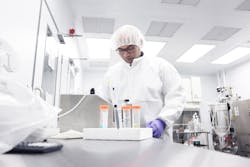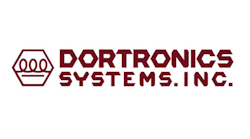While cleanrooms are not a new concept in the world of manufacturing, they have certainly continued to expand to more and more applications as technologies and research processes have evolved. From the early days of the space program, cleanrooms were used to help reduce dust contamination that could cause devices to fail in space. Today, cleanrooms are used for scientific research, optics and electronic component production, pharmaceutical and biotech labs and others to provide sterile operating conditions that meet regulatory classifications and industry standards.
Cleanrooms are “clean” because access into and out of the area is tightly controlled. The doors and framing materials have proper gaskets and seals to not allow contaminated air in or out of the area. The door hardware closes and reseals after each personnel passage.
Additional door devices may also be necessary to limit access to authorized persons and operate the airlock for environmental conditions. These can include card access systems, electric locks, station controls and traffic lights.
Because these and other safeguards are so critical in maintaining a cleanroom, it is prudent to ensure that best practices are followed when an integrator configures cleanroom access points for clients.
Vestibule Design
The vestibule is the main access point to the actual cleanroom. In order to seal the sterile room and also allow access to personnel, vestibules are constructed with two or more doors and only one door is allowed to be opened at a time.
A simple two-door airlock will have electric locks on each door which are normally unlocked. Opening either door will cause the other door to lock, preventing air and airborne particulates from entering or exiting the airlock.
The door hardware must cause the doors to close immediately after an entry or exit. These airlocks use door status switches to sense when a door has been opened and a door interlock controller then activates the locking mechanism of the unopened door.
An exception is if both doors are accessed simultaneously, which will make it impossible to prevent potential contamination through the unsealed doorway. One solution for this condition is to have one or both doors normally locked. Access can be granted through a locked door by card access, push button controls, etc., and a “normally” locked door provides an additional layer of protection as a request for access is denied if any other door is unsecure.
If the request for access device is a simple pushbutton with a momentary switch, it should be located adjacent to the door and within arm’s reach for easy access. Should persons have their hands full when needing access, a “touchless” wave-switch or PIR motion detector with a time delayed relock function may be needed. Card access controls will have the delayed relock built into the system.
Emergency Exit
In some situations, local building codes may require special lock override controls to enable personnel to escape the area in an emergency. Since only one door can be accessed at a time by design, the system must be tied into the fire alarm system to unlock the doors in case of fire.
An emergency override switch should be located within the room and at each doorway into the room. These devices can operate the door lock directly as well as signal the door interlock controller.
Some facilities use an emergency pull station or a latching push-pull switch with a key reset to override the system and unlock the necessary doors. These devices frequently incorporate a built-in sounder to alert area personnel that the doors are unlocked for uninhibited ingress or egress.
Unique Situations
In situations where the visibility of the second door is obscured, traffic lights can be used. A normally unlocked door will have an indicator that is green that then turns red when the door is locked. If the door is normally locked, then the light should be green to indicate access is allowed, but red when the door is inhibited from being unlocked.
PLC-based controllers can easily provide this function; however, most relay logic interlocks cannot. The best traffic indicators are LEDs in lieu of old-style incandescent bulbs. The large, super-bright and high-intensity LEDs are best for these applications and operate for an extended life cycle.
Door closer malfunctions can be resolved with a door prop alarm function. This may be incorporated into the PLC programmed logic or can be an independent standalone alert device. The door prop function monitors how long the door remains opened and should it not be closed in a predetermined time, then an alert is sounded.
Complex traffic patterns can be easily accommodated using a PLC-based controller. These can involve dozens of doors and some doors may be used to pass between two sterile rooms. This situation requires that all doors in each of the two rooms be secured whenever the “shared” door between them is open. The shared door may be normally unlocked for faster traffic if the other doors in the two rooms are normally locked.
Updates and Retrofits
The need for expanded space or changes in production may require special considerations such as a modular design; however, modular cleanrooms are not typically supplied with door interlocks and must be retrofitted in the field. As a result, cleanroom manufacturers benefit from using door interlock controls as an option for additional or existing installations as a means of addressing these changing conditions.
Further, the addition of door interlocks not only ensures the cleanroom meets the necessary ISO classifications by enforcing clean air control, but can also add a level of security within the controlled environment of the cleanrooms.
Depending on the manufacturing process, other interlock system considerations may include:
- Air system control;
- Traffic controls;
- User feedback indication;
- Automatic door openers;
- Emergency override;
- Access control; and
- Door alarms.
The construction of some modular cleanrooms may also limit the number and types of interlock devices that may be compatible. This is frequently addressed with factory-customized mounting hardware for locks and control switches.
Bryan Sanderford is National Sales Manager for Dortronics Systems Inc., a supplier of standard and customized controls for cleanrooms, including specialized interlock devices. Request more information by visiting www.securityinfowatch.com/10213494.



